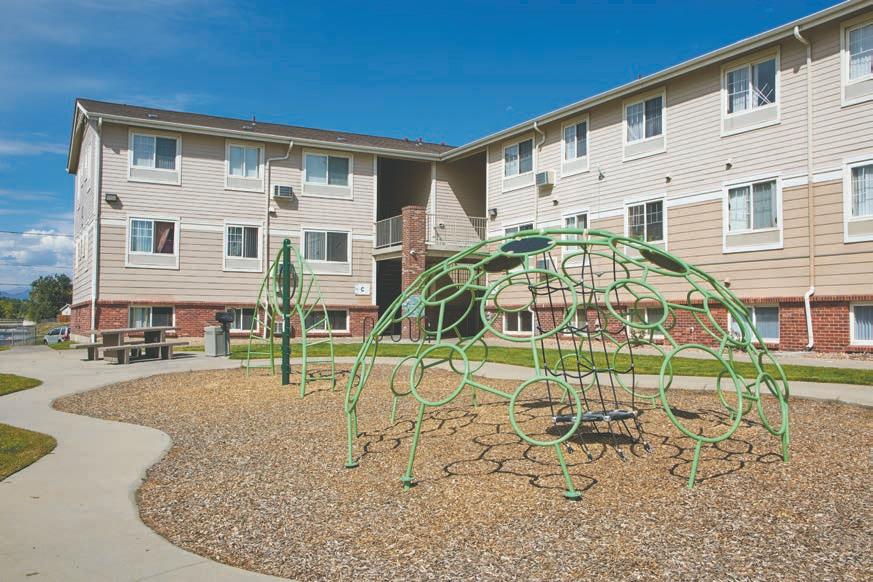
6 minute read
The most vulnerable of the housing crisis The Long Way Home
BY MICHAEL DE YOANNA MICHAEL@COLORADOCOMMUNITYMEDIA.COM

Our monthlong series exploring the affordability and accessibility of housing in the Denver area takes a turn to one of the most perplexing issues facing our communities: the lives of those who have no homes. Point-in-time counts in Adams, Arapahoe, Broomfield, Denver, Douglas and Jefferson counties find 2,000 people living unsheltered and 3,000 in emergency shelters. Most of those people were found in Denver but many live in our communities and neighborhoods.
While panhandlers and tent cities are visible across the metro area, many of the unhoused are unseen and may not even be included in the numbers because they are sleeping on a friend’s couch or a family that’s living in a relative’s extra room. The federal government includes this status in its definition of homelessness, along with those who are at imminent risk of losing a roof over their heads.
Homelessness has long been a problem in the metro area and the soaring housing costs that we’ve tracked in our series certainly don’t help. Typically, a family shouldn’t spend more than 30% of their wages on rent and utilities. Elsewhere in our series, we’ve found that many people across the metro area are living paycheck to paycheck and struggling to afford a place to live. Minimum wage earners might spend upward of 60% of their paychecks on rent.
Across the Front Range, rising housing costs are worsening the problem. In Littleton, south of Denver, the price of singlefamily homes has jumped roughly $300,000 since 2017. Lone Tree saw increases in excess of $473,000. In Brighton, $225,000.
Apartment rents have followed in recent years, part of a trend spanning the last two decades where median prices rose faster than median household incomes “in every Colorado county and city with 50,000+ residents,” according to Denver-based Root Policy Research, which analyzes housing affordability issues.


Some of the most needy in our communities find homes through federal funding, like vouchers. But the system, reporter Nina Joss finds, is based on lotteries, where people in need of housing may wait for years before winning. Others wind up roughing it on the streets, as reporters Andrew Fraieli and Olivia Love discovered in an interview of a man who lost his legs sleeping under a highway bridge during a horrific snowstorm.
There are consequences to it all, like how the mentally ill are especially vulnerable to homelessness and highly likely to find themselves in the criminal-justice system — meaning a record of police contacts for crimes connected to their situation, such as trespassing, becomes a barrier that prevents them from turning their lives around. There are costs associated with this to taxpayers, like those associated with providing more policing and beds in jails. Trends like those will be on Colorado Community Media’s newsroom in the months ahead.
Contributors to the project include:
residents like Laney have struggled to live in their communities.
“I’ve always felt like I was just passing through instead of living somewhere, putting down roots,” said Laney. He has worked at Jake’s Brew Bar in Littleton since 2012.
“ is is where I want to be,” Laney said. “My friends and family are Jake’s.” e median price of a single-family home in the metro area has roughly tripled since 2010, according to an August 2022 report by the Colorado Association of Realtors. Back in 2010, the median price was about $200,000.
In numerous counties, residents — spanning a range of employment from the service industry to teaching — have faced the brunt of what many o cials are calling a housing crisis.
And wages have not kept up with home costs. Between 2000 and 2019, median rents rose at a faster rate than household incomes “in every Colorado county and city with 50,000+ residents,” according to a November 2021 report from Denver-based consulting rm Root Policy Research. e report also said that, as of June 2021, Colorado’s overall housing inventory was 13% of what is needed for a functioning sales market.
“Quite honestly, we just don’t have enough housing, whether it’s a ordable or otherwise,” said Kelly Milliman, city council member for Littleton’s District 4 and a member of the city’s housing task force. “It’s really vitally important to the overall health of our community going forward.” e sentiment is similar for leaders in the neighboring cities of Englewood and Sheridan. ere, o cials said a ordable home options used to be more common.
“For the people that can a ord it, they have lots of choices in the metro area,” said Brad Power, Englewood’s director of community development. “But we’re starting to see more gaps with people who are on the other side of the income spectrum.”
Devin Granberry, city manager for Sheridan, said higher home costs have driven workers out of what he described as a historically blue-collar area.
“It leads to a very transient pipeline of citizenry and workforce,” he said. “ ere’s no sense of belonging, there’s no sense of ownership, and all of those are negative impacts on a community, the well-being of a community.”
Searching for a home

After leaving the house he owned near Houston, Texas, more than a decade ago, Laney knew buying a home in Denver would be a near-impossible feat.
He was making good money at a medical diagnostics company and had been able to purchase a brand-new home in a Houston suburb for less than $150,000. But his mental health was suffering and he knew he needed a change. With friends living in Colorado at the time, Laney decided to move more than 1,000 miles north to Denver.
With his fresh start came the opportunity to dive into a longtime passion: wine. He took classes to become a sommelier — a trained wine professional. He sold wine to businesses across the metro area, worked part-time at a cozy wine bar and restaurant in the heart of Littleton’s historic downtown, and eventually landed a full-time job at Jake’s.
Laney settled on wherever he could nd the most a ordable apartment — something hovering around $1,000 per month, in places around Denver. e ones he found in Littleton were too run-down. As rents around the region rose, Laney moved ve times in six years.
“During this whole process I knew I wanted a house,” Laney said. “I wanted something that was my own, and it’s hard to build a home in an apartment, especially when you keep moving.”
Laney’s experiences came as Littleton residents expressed less con dence that their city was affordable. From 2012 to 2022, residents who cited a ordable cost of living as a reason for living in Littleton declined from 30% to 14%, according to biennial city-issued surveys of hundreds of residents. Over those same years, residents who said a ordable housing and rental rates were a reason for living in the city went from 20% to 9%.
Laney said he worked, saved and kept his spending habits to a minimum during those years, staying laser-focused on his ultimate prize. Credit-card debt from college “really destroyed a lot of opportunities,” he said, but he kept “working, working, working.”
Even though Laney estimates he was making about $48,000 yearly, he says he was far short of what he needed for a down payment on even the least expensive of homes in Littleton.
He wasn’t alone. A 2020 analysis from Denverbased contractor Root Policy showed that individuals who earned $29,000 to $95,000 yearly in the metro area could not a ord the average price of a home, which was nearly $420,000 that year.

Pet Adoptions
Meet MISS TINA!
Miss Tina is 7 months old and is wasting her youth away at the shelter. She is ready for a forever home with a nice poofy cat bed and a human to love her. She is affectionate but not needy and does well with other cats and dogs. Fill out an app at imhs.org.

“It’s a pretty serious situation,” said Corey Reitz, executive director of Littleton’s housing authority, South Metro Housing Options. “ e list of folks who can’t continue to live here continues to grow.” at list, according to Root’s analysis, includes workers in health care, education, construction, food service and more.
Essential workers risk being priced out Sta ers at Swedish Medical Center in Englewood say the housing problem also a ects them. ey blame the shortage of essential hospital workers they’re contending with, in part, on the cost of housing.
“Absolutely the rising cost of housing here in Colorado is a topic,” said Dena Schmaedecke, the hospital’s vice president of human resources. “Colleagues are often bringing up those stresses.” at housing-cost factor has caused hospital leaders to o er a $10,000 housing stipend to incentivize new employees, Schmaedecke said.
In Brighton, northeast of Denver, Michael Clow, chief human resources o cer for 27J Schools, said the cost of housing has impacted the district’s ability to maintain and support sta .

“We hear from candidates and from our new hires that the cost of housing and their ability to nd housing is a real problem,” Clow said. “ We recently had two math teachers (husband and wife) join us. ey were excited to live their dream and move to Colorado. After just one year and realizing they could not a ord to raise a family here, they moved back to their home state.”
Clow said the crisis has restricted the district’s pool of applicants graduating with teaching degrees, creating intense competition for sta and teachers.
“ e cost of housing is becoming a serious obstacle for us to maintain service levels and serve our mission,” he said.


Farther north, in Fort Lupton, the Weld R-8










